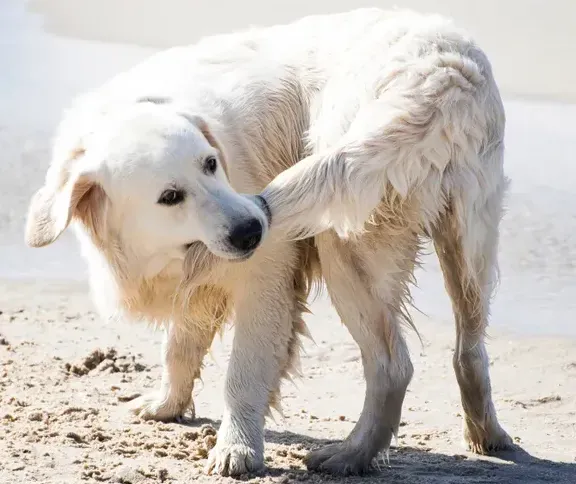Dogs chasing their tails is a curious behavior, and understanding why they do it is important. Insights from experts like the American Kennel Club shed light on the reasons behind this behavior. Discover why dogs chase their tails."
Some of the reasons why dogs chase their tails include play and entertainment, behavioral issues, seeking attention, compulsive behavior, and even underlying medical issues. Each of these factors can contribute to tail-chasing behavior, and it's important to recognize the signs and address any concerning symptoms. Not all instances of tail chasing are alarming, but it's crucial to be aware of when professional help may be necessary.
Responsible dog ownership involves understanding tail-chasing causes, recognizing compulsive behavior, and prevention methods. Offer mental and physical stimulation, address anxiety, redirect focus, consult a vet, and seek professional help if needed for your dog's well-being.

Why Do Dogs Chase Their Tails?
Dogs chasing their tails is a common behavior that can be observed in many canine species. The reasons behind this behavior can vary, but there are a few common explanations.
Boredom or excess energy may lead to tail chasing in dogs. This behavior can be a result of insufficient mental and physical stimulation. To alleviate it, ensure your dog gets enough exercise and engaging activities. Additionally, tail chasing can be a sign of anxiety or stress, so addressing the root causes is essential.
Some dogs may simply chase their tails out of habit or for attention. If they have received attention or treats in the past when performing this behavior, they may continue to do it as a way to seek attention from their owners. Consistently ignoring or redirecting this behavior can help discourage it.
Now, let me share a true story that perfectly illustrates this behavior. I once had a dog named Max who would chase his tail whenever he was excited. We noticed that every time we came home after being away for a while, Max would start spinning in circles, trying to catch his tail. It became a funny routine for us, and we would sometimes play along by pretending to chase his tail with him. Eventually, as Max grew older and calmer, the tail-chasing behavior subsided. It was a quirky and endearing part of Max's personality that we will always remember. Dogs chasing their tails can be a humorous and entertaining behavior, but it's important to ensure that it does not become obsessive or harmful to the dog.
What Are the Possible Reasons for Dogs Chasing Their Tails?
Dogs chasing their tails can be an amusing and perplexing behavior. In this section, we'll explore the possible reasons behind this intriguing behavior. From play and entertainment to behavioral issues, seeking attention, compulsive behavior, and medical issues, we'll dissect the various factors that may drive dogs to engage in this tail-chasing frenzy. Get ready to unravel the mysteries behind this quirky canine behavior!
1. Play and Entertainment
When it comes to dogs chasing their tails, play and entertainment is often one of the main reasons for this behavior. Here are some factors to consider:
- Dogs may chase their tails for play and entertainment purposes, similar to how they might chase a ball or a toy. This activity can provide them with both mental and physical stimulation.
- Tail chasing can also serve as a source of self-entertainment for dogs when they are bored or lacking sufficient stimulation. It becomes a behavior that rewards itself, allowing them to release any excess energy they may have.
- Some dogs may engage in tail chasing to seek attention from their owners or other people around them. They may enjoy the response they get, even if it includes negative attention, such as being told to stop.
- In some cases, tail chasing can develop into a compulsive behavior. This means that the dog repetitively and excessively engages in this behavior, sometimes ignoring other activities or experiencing distress.
- While play and entertainment are often harmless reasons for tail chasing, it is essential to consider any potential underlying medical issues that could cause or worsen this behavior.
A true story that exemplifies the play and entertainment aspect of tail chasing is the case of Charlie, a Labrador Retrievertail-chasing. Charlie loved playing fetch and would often chase his tail as a form of self-entertainment when there were no balls around. His family noticed that he would wag his tail happily while chasing it, and they realized that it was simply a playful behavior for him. They ensured he had a variety of toys and dedicated playtime to keep him mentally and physically stimulated, resulting in him engaging in tail chasing less frequently.

2. Behavioral Issues
When trying to understand why a dog chases its tail, it is crucial to consider behavioral issues that might contribute to this behavior. Addressing these issues is vital for the well-being of the dog.
Boredom or a lack of mental and physical stimulation is one common cause of tail-chasing behavior in dogs. Dogs are highly energetic animals that require regular exercise and mental engagement to remain content. Insufficient stimulation can result in behaviors like tail chasing as a means for the dog to amuse itself.
Another behavioral issue that can lead to tail chasing is anxiety or stress. Dogs that experience anxiety or stress may display compulsive behaviors, including tail chasing. This behavior can serve as a coping mechanism for the dog to relieve their anxiety.
To tackle behavioral issues associated with tail chasing, it is important to provide adequate mental and physical stimulation for the dog. Engaging in activities such as interactive play, puzzle toys, and regular exercise can help alleviate boredom.
To reduce tail-chasing behavior in dogs, addressing anxiety and stress is crucial. Techniques like positive reinforcement training, creating a calm environment, and providing comfort can help. Redirecting their focus to alternative activities is key to breaking this cycle. Discover why dogs chase their tails.
If tail chasing persists despite these interventions, it is recommended to seek advice from a veterinarian. They can evaluate the underlying cause of the behavior and develop a targeted treatment plan.
Fact: Dogs may also chase their tails due to medical reasons such as allergies, parasites, or pain. Therefore, it is important to rule out any potential medical issues before solely attributing tail chasing to behavioral causes.
3. Seeking Attention
When dogs chase their tails, one possible reason is that they are seeking attention. This behavior can manifest in various ways and may indicate a dog's desire for interaction or connection with their owner or other people.
- Eye contact: Dogs seeking attention may make direct eye contact with their owners, trying to capture their attention and engage them in play or interaction.
- Whining or barking: When dogs want attention, they may vocalize through whining or barking to get their owner's attention and initiate interaction.
- Pawing or nudging: Dogs may seek attention by pawing at their owners or nudging them with their noses, signaling their desire for interaction.
- Jumping or spinning: Some dogs may engage in attention-seeking behaviors such as jumping or spinning in circles to capture their owner's attention and encourage interaction.
- Following closely: Dogs seeking attention may constantly stay by their owner's side, following them around and seeking physical contact or engagement.
Understanding the signs of seeking attention can help dog owners respond appropriately to their pet's needs. Providing plenty of affection, playtime, and quality time together can help fulfill the dog's need for attention and reduce tail-chasing behavior.
In history, dogs have always sought attention from humans. From ancient civilizations to modern times, dogs have relied on their ability to gain attention to form strong bonds with their human companions. This attention-seeking behavior has been crucial in building the unique and mutually beneficial relationship between dogs and humans that has endured throughout history.
4. Compulsive Behavior
When it comes to dogs, compulsive behavior refers to repetitive actions that they engage in without any apparent reason or purpose. This behavior can manifest in various ways, including tail chasing.
| Factors | Details |
|---|---|
| 1. Frequency | Compulsive tail chasing occurs frequently, with the dog repeatedly chasing its tail for extended periods. |
| 2. Inability to Stop | The dog is unable to stop chasing its tail even when interrupted or distracted. |
| 3. Self-Injury | Compulsive tail chasing can result in self-injury, such as hair loss, skin irritation, or even wounds on the tail. |
| 4. Distress | The behavior often causes distress to the dog, leading to anxiety or frustration. |
| 5. Interference with Daily Activities | If tail chasing becomes excessive, it can interfere with the dog's ability to eat, sleep, or interact with its surroundings. |
Addressing compulsive tail chasing is crucial for the well-being of the dog. Here are some strategies that can help:
1. Provide Adequate Mental and Physical Stimulation: Engage your dog in regular exercise, play sessions, and mental stimulation activities to redirect their energy and focus.
2. Address Anxiety and Stress: Identify any underlying anxiety or stress triggers and work on reducing or managing them through behavior modification techniques or professional assistance.
3. Redirect Their Focus: Interrupt the tail-chasing behavior and redirect your dog's attention to a more appropriate activity or toy.
4. Consult with a Veterinarian: Seek guidance from a veterinarian who can assess the behavior and provide further advice, including the possibility of medication if necessary.
Remember, compulsive behavior in dogs should never be ignored. By understanding and addressing this behavior promptly, you can help improve your dog's overall well-being.
Pro-tip: Consistency and patience are key when addressing compulsive behavior in dogs. Implementing a structured routine and providing a calm and supportive environment can aid in managing and reducing the compulsion over time.
5. Medical Issues
When dogs chase their tails, various underlying medical issues could be at play. Discover why dogs chase their tails and explore potential medical causes.
- Parasites: Internal parasites such as fleas, ticks, or worms can cause itching and discomfort, leading dogs to chase their tails.
- Skin Allergies: Allergies to certain foods, environmental factors, or even fleas can cause skin irritation and itching, triggering tail-chasing behavior.
- Infections: Infections, such as bacterial or yeast infections, can lead to irritation and itching in the tail area, causing dogs to chase their tails.
- Neurological Disorders: Certain neurological conditions, like compulsive disorders or seizures, may manifest in repetitive behaviors such as tail-chasing.
- Anal Gland Issues: Dogs have anal glands that can become impacted or infected, leading to discomfort and tail-chasing as a way to alleviate the discomfort.
It is important to note that while medical issues can be a potential cause for tail-chasing behavior, they are not always the case. It is essential to rule out any medical conditions before addressing other factors that may contribute to this behavior.
Fact: Approximately 20% of dogs exhibiting tail-chasing behavior have an underlying medical issue as the cause.
What Are the Signs of Compulsive Tail Chasing in Dogs?
The signs of compulsive tail chasing in dogs can vary, but there are some common indicators to look out for:
- Repetitive behavior: Dogs that compulsively chase their tails will often do so in a repetitive manner. They may spin in circles or continuously pursue their tail without any interruption.
- Fixation on the tail: Dogs with this behavior will display an intense fixation on their tail. They may constantly stare or bark at it, unable to divert their attention elsewhere.
- Loss of interest in other activities: Dogs with compulsive tail chasing may lose interest in other activities such as playing, eating, or interacting with their owners. Their focus is solely on chasing their tail.
- Injuries: Excessive tail chasing can lead to injuries. Dogs may bite or chew at their tail to the point of causing abrasions, irritations, or hair loss.
- Emotional distress: Compulsive tail chasing can be a sign of underlying emotional distress or anxiety. Dogs may exhibit signs of restlessness or seem agitated during episodes.
- Frequency and duration: The frequency and duration of tail-chasing episodes may vary. Some dogs may engage in this behavior sporadically, while others may do it for prolonged periods of time.
If you notice any of these signs in your dog, it is important to consult with a veterinarian or a professional dog behaviorist. They can help determine the underlying cause of the behavior and provide guidance on how to manage or treat compulsive tail chasing in dogs.

How Can You Help Prevent or Stop Your Dog from Chasing Its Tail?
"To help your dog overcome tail-chasing, discover effective strategies for why dogs chase their tails. Learn how to provide mental and physical stimulation, address anxiety and stress, redirect their focus, and consult with a veterinarian. These practical tips can make a significant difference in ending your dog's tail-chasing adventures."
1. Provide Adequate Mental and Physical Stimulation
Providing adequate mental and physical stimulation is vital for dogs to prevent or reduce tail-chasing behavior. Here are some effective ways to achieve this:
- Engage in daily exercise: Regular physical activity has numerous benefits for dogs, including restlessness and anxiety reduction. Take your dog for walks, play fetch, or participate in other activities that fulfill their exercise needs.
- Use puzzle toys: Mental stimulation is equally important for dogs. Challenge their problem-solving skills and keep them mentally engaged with puzzle toys and interactive games. Fill treat-dispensing toys with their favorite snacks to encourage play and exploration.
- Train and teach new tricks: Dogs thrive on learning and mastering new skills. Dedicate time for training sessions to teach them obedience commands, tricks, or even agility exercises. This stimulates their minds and strengthens the bond between you and your dog.
- Rotate toys and activities: Keep things interesting for your dog by regularly introducing new toys and rotating them to avoid boredom. Interactive toys like treat-dispensing balls or puzzle games provide mental stimulation and keep them occupied.
- Provide social interaction: Dogs are social animals, and interaction with other dogs or humans greatly enriches their lives. Take them to dog parks, arrange playdates, or attend training classes where they can socialize and engage in playful activities with others.
- Consider doggie daycare or dog walkers: If you're too busy to provide sufficient physical exercise or mental stimulation, consider enrolling your dog in a reputable doggie daycare or hiring a dog walker who can fulfill their exercise and social needs.
By incorporating these strategies into your dog's routine, you can ensure they receive the mental and physical stimulation necessary to prevent or minimize tail-chasing behavior.
2. Address Anxiety and Stress
Addressing anxiety and stress in dogs is crucial for managing tail-chasing behavior. Here are some effective strategies:
- Provide a secure and calm environment: Creating a peaceful atmosphere at home can help reduce anxiety in dogs. Minimize loud noises and ensure your dog has a comfortable space to relax.
- Establish a routine: Dogs thrive on routine and predictability. Address anxiety and stress by establishing a consistent daily schedule that can help alleviate stress and anxiety.
- Positive reinforcement training: Use positive reinforcement techniques to reward calm and relaxed behavior. This can include treats, praise, and playtime.
- Engage in mental and physical stimulation: Dogs need regular exercise and mental stimulation to address anxiety and stress and keep their minds and bodies healthy. Incorporate activities like daily walks, puzzle toys, and obedience training sessions.
- Provide a safe space: Create a designated area or crate where your dog can retreat to when they feel anxious or stressed. Make this space comfortable with their favorite toys and blankets.
- Use calming aids: Consider using calming aids like pheromone diffusers, anxiety wraps, or natural supplements under the guidance of a veterinarian to address anxiety and stress.
- Seek professional help: If your dotail-chasingand stress are severe or persistent, consult with a veterinarian or a professional dog behaviorist for a comprehensive assessment and tailored treatment plan.
By addressing anxiety and stress in dogs, you can help reduce tail chasing behavior and improve their overall well-being.
3. Redirect Their Focus
Redirecting a dog's focus can be an effective way to prevent or stop tail-chasing behavior. Here are some steps you can take to redirect your dog's focus:
- Introduce interactive toys: Provide your dog with toys that engage their mind and require mental effort, such as puzzle toys or treat-dispensing toys. These toys can redirect their focus and keep them mentally stimulated.
- Engage in interactive play: Play interactive games with your dog, such as fetch or hide-and-seek. This can divert their attention away from tail chasing and redirect their energy into positive activities.
- Redirect their focus by teaching obedience commands: Train your dog to respond to basic obedience commands like "sit," "stay," or "leave it." By redirecting their focus onto these commands, you can divert their attention away from tail chasing.
- Provide structured exercise: Regular exercise is essential for dogs, as it helps burn off excess energy and prevents boredom. Take your dog for daily walks or engage in activities like agility training to redirect their focus and promote overall well-being.
- Use positive reinforcement: Whenever your dog displays alternative behaviors to tail chasing, such as playing with toys or following commands, reward them with treats or praise. This positive reinforcement will encourage them to engage in these behaviors instead of tail chasing.
To address why do dogs chase their tails, redirect their focus to engaging activities. Stay patient and consistent. If issues persist, consult a veterinarian or dog trainer. These strategies promote a positive experience for you and your furry friend.

4. Consult with a Veterinarian
When consulting with a veterinarian about a dog that is chasing its tail, it is important to ensure that the underlying cause is properly addressed. Here are some steps to follow when consulting with a veterinarian:
- Schedule an appointment: Contact your veterinarian to schedule a consultation regarding your dog's tail-chasing behavior. Provide them with a detailed description of the behavior and any observations you have made.
- Provide medical history: During the appointment, share your dog's complete medical history, including any previous or current medical conditions, medications, or treatments your dog may have received. This information is crucial for the veterinarian to understand your dog's overall health.
- Discuss behavior history: Describe the frequency, duration, and intensity of your dog's tail-chasing behavior. Mention any triggers or situations that seem to initiate the behavior, as well as any changes in the behavior over time.
- Diagnostic tests: Based on the information provided, the veterinarian may recommend certain diagnostic tests to rule out any underlying medical conditions that could be causing or contributing to the tail-chasing behavior. These tests may include blood work, imaging, or other specialized exams.
- Follow recommended treatments: Depending on the veterinarian's evaluation, they may recommend specific treatments or interventions to address the tail-chasing behavior. This could involve behavior modification techniques, medication, or a combination of both.
- Communicate openly: Keep the lines of communication open with your veterinarian. Provide feedback on any changes in your dog's behavior or if new symptoms arise. This will help the veterinarian assess the effectiveness of the recommended treatments and make any necessary adjustments.
Remember, consulting with a veterinarian is essential to ensure that your dog's tail-chasing behavior is properly evaluated and treated. By following these steps, you can work with your veterinarian to address the underlying cause and help your dog lead a happier and healthier life.
Is Tail Chasing Always a Concerning Behavior?
Tail chasing in dogs is not always a concerning behavior. While it may seem odd or amusing, it is important to understand that dogs engage in this behavior for various reasons.
1. Playfulness: Is tail chasing always a concerning behavior? Dogs may chase their tails as a form of play. It is a way for them to release excess energy and entertain themselves.
2. Attention seeking: Is tail chasing always a concerning behavior? Some dogs chase their tails to get attention from their owners or other people around them. They may have learned that this behavior elicits a response from humans.
3. Boredom: Is tail chasing always a concerning behavior? Dogs that are bored or underestimated may resort to tail chasing as a way to entertain themselves. Providing them with mental and physical stimulation through toys, games, and exercise can help alleviate this behavior.
4. Anxiety or stress: Is tail chasing always a concerning behavior? In some cases, tail chasing can be a sign of anxiety or stress in dogs. If a dog exhibits other signs of anxiety, such as pacing, panting, or excessive whining, it may be a cause for concern. Consulting a veterinarian or a professional dog trainer can help address anxiety-related tail chasing.
5. Medical issues: Is tail chasing always a concerning behavior? Although rare, there are instances where tail chasing can be a symptom of an underlying medical condition. If a dog obsessively and persistently chases its tail, it is essential to rule out any medical issues such as allergies, skin irritations, or pain.
It is important to consider the frequency, intensity, and context of tail chasing when determining whether it is a concerning behavior. If the behavior becomes excessive, interferes with daily activities, or is accompanied by other concerning signs, seeking professional advice is recommended. Otherwise, tail chasing can simply be a normal and harmless behavior in dogs.

When Should You Seek Professional Help for Tail-Chasing Behavior?
Knowing when to seek professional help for tail-chasing behavior in dogs is crucial for their well-being. Here are some important factors to consider:
- When Should You Seek Professional Help for Tail-Chasing Behavior? If your dog is tail chasing occasionally and for short periods, it is often considered normal behavior. If the behavior becomes frequent or persists for extended periods, it may indicate an underlying issue that requires professional attention.
- Injury or self-mutilation: If the tail-chasing behavior leads to self-injury, such as bleeding or hair loss, it is important to seek professional help immediately. This could be a sign of a medical condition or psychological distress that needs to be addressed by a veterinarian or animal behaviorist.
- Changes in behavior: If your dog's tail-chasing behavior is accompanied by other changes in behavior, such as aggression, anxiety, or obsessive-compulsive tendencies, it is recommended to consult a professional. These changes could be indicators of underlying health or behavioral issues that require professional intervention.
- Impact on daily life: If the tail-chasing behavior interferes with your dog's ability to eat, sleep, or engage in normal activities, professional help should be sought. It is important to ensure that your dog's quality of life is not compromised due to the behavior.
- Lack of improvement: If you have tried various methods to address the tail chasing behavior, such as environmental enrichment, behavior modification techniques, or training, and have not seen any improvement, it is advisable to consult a professional. They can provide guidance and expertise to help address the underlying cause of the behavior.
Remember, seeking professional help for tail-chasing behavior is essential to ensure the well-being of your furry friend.
In conclusion, understanding why do dogs chase their tails is essential for responsible pet ownership. By addressing root causes and redirecting their focus, we can promote healthier and happier canine companions.
Frequently Asked Questions
Why do dogs chase their tails for fun and games?
Dogs may chase their tails as a playful behavior, simply finding it entertaining. It can be a sign of them enjoying themselves and expressing their excitement.
How can understanding compulsive behavior help in managing tail chasing?
Recognizing tail chasing as a compulsive behavior can help pet owners seek appropriate medical or behavioral treatment. Understanding the underlying causes and triggers can aid in developing effective strategies for redirecting attention and preventing the behavior from worsening.
Is it common for dogs to chew their tails?
While tail chasing is more common, some dogs may chew their tails as well. However, tail chewing can be a concerning behavior and may indicate underlying issues such as anxiety, grooming problems, allergic reactions, or even trauma to the tail or spine.
Who can provide animal behavioral consultation for tail-chasing dogs?
If a dog's tail-chasing behavior becomes concerning or compulsive, consulting with a veterinary behaviorist or a qualified animal behaviorist can provide valuable insights and guidance. They can assess the individual circumstances and develop a suitable treatment plan.
Are there any risks associated with tail chasing?
Tail chasing itself is not typically dangerous, but if it becomes a compulsive behavior, dogs may start biting their tail, leading to potential injuries. Additionally, if the behavior is triggered by anxiety or stress, it can negatively impact a dog's physical health and overall well-being.
What role does veterinary care play in managing tail-chasing behavior?
Seeking veterinary care is crucial to rule out any underlying medical conditions that may contribute to tail chasing. Intestinal parasites, physical injuries, or other health issues can be addressed through a proper diagnosis and treatment plan, supporting the management of the behavior.






